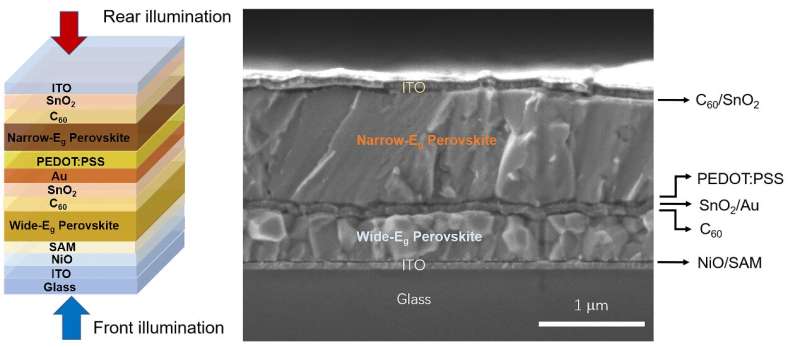Bifacial monolithic all-perovskite tandem solar cells form new architecture
by Light Publishing Center, Changchun Institute of Optics, Fine Mechanics And Physics, CAS

Metal halide perovskite solar cells have attracted enormous attention as their power conversion efficiencies (PCEs) continued to increase from below 4% to over 25%. Further improving the performance with low additional costs is crucial for commercializing perovskite solar cells. One of the most promising routes is to adopt the tandem configuration to overcome the Shockley-Queisser limit of single-junction solar cells.
By stacking two absorbers with complementary bandgap, tandem solar cells promise higher PCEs than their single-junction counterparts. Perovskites are highly desirable for tandem solar cells. All-perovskite tandem solar cells are highly promising due to their low cost, high specific power, and flexibility.
In a new paper published in eLight, a team of scientists, led by Professor Hairen Tan from Nanjing University, have demonstrated the first bifacial monolithic all-perovskite tandem solar cells. Their paper, “Revealing the output power potential of bifacial monolithic all-perovskite tandem solar cells,” found that their device had significantly higher output power potential.
Monolithic all-perovskite tandems have vastly improved to the recently certified value of 28.0%. Despite those advancements, other strategies for achieving higher output power density (OPD) are still highly desired to bring down the levelized cost of energy (LCOE). Another effective strategy to increase the OPD of perovskite solar cells is to take advantage of bifacial configuration. It allows significant OPD gain by utilizing the light reaching the back side of the devices, namely the albedo (the reflected and scattered light from the surroundings).
Using transparent conductive oxide (TCO) as rear electrodes, bifacial perovskite solar cells can be constructed based on the well-established mono-facial configuration. More importantly, bifacial perovskite solar cells would be more stable than their mono-facial counterparts. Numerical simulation shows that bifacial tandem cells can inherit the advantages of tandem architecture and bifacial design. It would allow higher thermodynamic efficiency beyond mono-facial tandems and single-junction bifacial solar cells.
In the presence of albedo, the optimized current matching design in mono-facial tandems will lead to a mismatch in bifacial configuration. The current of the bottom subcells will be increased with albedo in bifacial monolithic tandems. Compared to mono-facial tandems, the rear transparent electrodes will reduce the current in the bottom subcells by allowing light to transmit without rear reflection. The current matching must be redesigned in bifacial tandem configurations.
The research team demonstrated the design and fabrication of bifacial all-perovskite tandem solar cells by using transparent conductive oxide (TCO) as the rear electrode. Bandgap engineering of the top subcell was deployed to obtain current matching under various rear illumination. The effect of albedo on the photovoltaic parameters and the spectral response has been systematically investigated. Energy yield calculation reveals higher output power density by utilizing bifacial architecture under real-world conditions.
The bifacial all-perovskite monolithic tandems were demonstrated using transparent rear electrodes. It enables the harvest of light impacting the rear side of the tandems. The bifacial tandems showed more remarkable performance improvement than the mono-facial tandems. Only the top subcell bandgap was adjusted to achieve the current matching of bifacial tandems with rear illumination, which was valid for albedo below 40%. For albedo over 40%, the current density of the tandems is saturated. The researchers proposed further decreasing the bandgap of the top subcells or increasing the bandgap of the bottom subcells.
Using ALD-deposited SnO2 and sputtered transparent conduction oxide (ITO) as rear contacts can avoid halide corrosion of rear electrodes. Reducing bromide content in the top cell can relieve halide segregation. Bifacial tandems showed substantial energy yield gain in real-world conditions with various presentive grounds in different climatic conditions. As the bifacial all-perovskite tandems aim to harvest light at the rear side to boost OPD, they are expected to be applicable at the utility-scale.
The researchers noted that their bifacial all-perovskite tandem fabricated on a grid glass substrate could also be processed on a flexible substrate for flexible bifacial all-perovskite tandem. Climate conditions and the grounds directly impact the intensity and spectrum of the albedo. Customized bifacial tandems with a different bandgap of top subcells are required for various climate conditions and grounds. The solar tracking technique will attract bifacial tandems to utilize the albedo. This work reveals the potential of bifacial all-perovskite tandems as a new device architecture for higher output power with enhanced stability.
Two-sided solar cells can collect scattered light to gather more energy
Hongjiang Li et al, Revealing the output power potential of bifacial monolithic all-perovskite tandem solar cells, eLight (2022). DOI: 10.1186/s43593-022-00028-w
Provided by
Light Publishing Center, Changchun Institute of Optics, Fine Mechanics And Physics, CAS
Citation:
Bifacial monolithic all-perovskite tandem solar cells form new architecture (2022, October 18)
retrieved 18 October 2022
from https://techxplore.com/news/2022-10-bifacial-monolithic-all-perovskite-tandem-solar.html
This document is subject to copyright. Apart from any fair dealing for the purpose of private study or research, no
part may be reproduced without the written permission. The content is provided for information purposes only.
For all the latest Technology News Click Here
For the latest news and updates, follow us on Google News.
